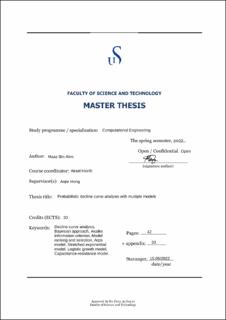| dc.description.abstract | Numerical models have been established to help understand the longevity of projects when
exploring and drilling for hydrocarbons. They aid in understanding and optimizing decisions on
the long-term feasibility of a project by using existing data to run simulations and estimate how
long a supply can be sustained before its depletion. This thesis aims to explore and evaluate how
different models compare to one another, how each model varies against the other, and
ultimately decide how to better optimize production forecasts. It also investigates two
approaches to the problem namely deterministic and probabilistic.
As petroleum production has increased, there has been a need for companies to meet demands
and that requires more accurate methods for reservoir evaluation and forecasting. Numerical
models can help in this case but which model to choose and to what extent can they be relied
upon are uncertain factors. This thesis aims to answer that question.
The challenge in this thesis is comparing probabilistic and deterministic approaches which has
not been done in other research before using real field data. | |
